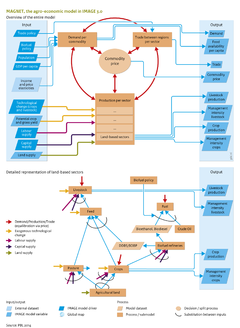Agricultural economy: Difference between revisions
Jump to navigation
Jump to search
No edit summary |
No edit summary |
||
| Line 4: | Line 4: | ||
|ExternalModel=EFIGTM model; | |ExternalModel=EFIGTM model; | ||
|KeyReference=Woltjer, 2011; Stehfest et al., 2013; | |KeyReference=Woltjer, 2011; Stehfest et al., 2013; | ||
|Reference=Woltjer et al., 2011; Kallio et al., 2004; Carpenter, 2006; | |Reference=Woltjer et al., 2011; Kallio et al., 2004; Carpenter et al., 2006; | ||
|InputVar=Population; GDP per capita; Capital supply; Labor supply; Trade policy; Biofuel policy; Land supply; Crop and grass yield - grid; Technological change (crops and livestock); Income and price elasticities of agricultural commodities demand; Land for bioenergy; | |InputVar=Population; GDP per capita; Capital supply; Labor supply; Trade policy; Biofuel policy; Land supply; Crop and grass yield - grid; Technological change (crops and livestock); Income and price elasticities of agricultural commodities demand; Land for bioenergy; | ||
|OutputVar=Crop production; Management intensity crops; Management intensity livestock; Food availability per capita; Commodity price; Livestock production; Demand (crop and lifestock); Trade (crop and livestock); | |OutputVar=Crop production; Management intensity crops; Management intensity livestock; Food availability per capita; Commodity price; Livestock production; Demand (crop and lifestock); Trade (crop and livestock); | ||
| Line 15: | Line 15: | ||
MAGNET uses information from IMAGE on land availability and suitability, and on changes in crop yields due to climate change and agricultural expansion on inhomogeneous land areas. The results from MAGNET on production and endogenous yield (management factor) are used in IMAGE to calculate spatially explicit land-use change, and the environmental impacts on carbon, nutrient and water cycles, biodiversity, and climate. | MAGNET uses information from IMAGE on land availability and suitability, and on changes in crop yields due to climate change and agricultural expansion on inhomogeneous land areas. The results from MAGNET on production and endogenous yield (management factor) are used in IMAGE to calculate spatially explicit land-use change, and the environmental impacts on carbon, nutrient and water cycles, biodiversity, and climate. | ||
Although MAGNET is the standard agro-economic model used with IMAGE, other models can be linked with IMAGE. For example, the IMPACT model was used with IMAGE in the Millennium Ecosystem Assessment ([[Carpenter, 2006]]), and in a PBL study on protein supply, both the MAGNET and the IMPACT model were used to study the same set of scenarios. This allowed a systematic comparison between IMPACT and MAGNET ([[Stehfest et al., 2013]]). | Although MAGNET is the standard agro-economic model used with IMAGE, other models can be linked with IMAGE. For example, the IMPACT model was used with IMAGE in the Millennium Ecosystem Assessment ([[Carpenter et al., 2006]]), and in a PBL study on protein supply, both the MAGNET and the IMPACT model were used to study the same set of scenarios. This allowed a systematic comparison between IMPACT and MAGNET ([[Stehfest et al., 2013]]). | ||
In IMAGE, demand for forest products can be derived from several sources, the most simplest being via a relationship with GDP or preferably, from specific forest demand models, such as [[EFIGTM model|EFI-GTM]] ([[Kallio et al., 2004]]). In the future, competition between forestry and other land uses can be included using the forestry module in MAGNET. Other land-use changes, such as infrastructure expansion, which do not require interregional links, are described in the land-use allocation module [[Agricultural systems]]. | In IMAGE, demand for forest products can be derived from several sources, the most simplest being via a relationship with GDP or preferably, from specific forest demand models, such as [[EFIGTM model|EFI-GTM]] ([[Kallio et al., 2004]]). In the future, competition between forestry and other land uses can be included using the forestry module in MAGNET. Other land-use changes, such as infrastructure expansion, which do not require interregional links, are described in the land-use allocation module [[Agricultural systems]]. | ||
Revision as of 13:04, 12 February 2014
Parts of Agricultural economy
| Component is implemented in: |
|
| Related IMAGE components |
| Projects/Applications |
| Key publications |
| References |
Key policy issues
- What is the area of cropland and grassland required to support future food demand?
- What are the policy options to reduce agricultural land use and to safeguard global biodiversity, while ensuring food security?
- How can the implications of biofuels for land use and greenhouse gases be managed sustainably?
